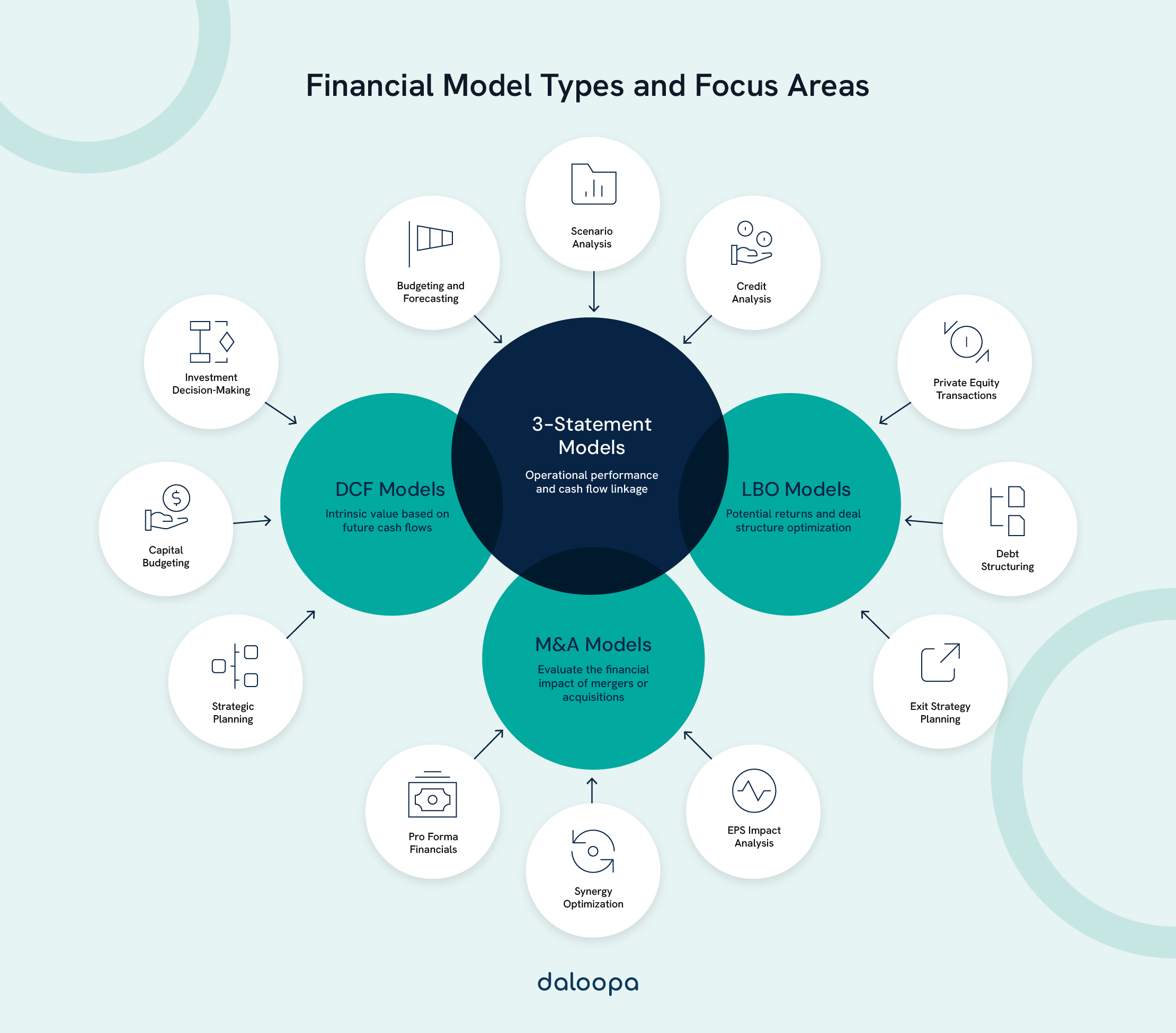Financial modeling in Excel helps finance professionals make well-informed decisions and guides strategic efforts. Building reliable models allows you to evaluate intricate financial scenarios, forecast future outcomes, and assess potential investments. Excel’s adaptability and robust functionality make it a prime choice for constructing complex financial models tailored to real-world business challenges.
Real-world examples of financial modeling in Excel highlight how these models move beyond theoretical frameworks, addressing specific, tangible challenges across industries. They integrate real data, market trends, and organizational details to yield actionable insights. Whether valuing startups or analyzing mergers and acquisitions, Excel-based financial models are indispensable for corporate finance teams, investment bankers, and analysts.
Key Takeaways
- Excel-based financial models empower strategic planning and evidence-based decisions.
- Industry-specific templates add precision and relevance to projections.
- Advanced techniques in financial modeling enhance reliability for forecasts and scenario evaluations.

Core Components of Financial Modeling
Creating a financial model involves combining critical elements to represent an organization’s financial standing thoroughly. These components form the backbone of decision-making and performance analysis.
3-Statement Models
The 3-statement model is the cornerstone of financial modeling, connecting the income, balance, and cash flow statements, ensuring changes in one financial area ripple through the others, providing a holistic view of a company’s financial health.
- Income Statement: Tracks revenues, expenses, and profits over a set period.
- Balance Sheet: Summarizes assets, liabilities, and equity at a specific point.
- Cash Flow Statement: Details cash inflows and outflows from operations, investments, and financing.
These statements are dynamically linked using Excel formulas, allowing for seamless updates when variables change. For example, adjusting the revenue growth rate in the income statement automatically updates cash flow and equity balances. This interconnectivity is crucial for accurate forecasting and impactful scenario planning.
Discounted Cash Flow (DCF) Models
DCF models are vital for valuing companies and assets by estimating the present value of future cash flows. Key steps in building a DCF model include:
- Forecasting Free Cash Flows: Using inputs like revenue growth, operating margins, and capital expenditures.
- Calculating Terminal Value: Applying perpetuity growth or exit multiples for long-term cash flows.
- Discounting to Present Value: Using the weighted average cost of capital (WACC).
Net Present Value (NPV) and Internal Rate of Return (IRR) outputs assess investment viability. For instance, a DCF model might consider future subscription revenues, customer churn, and product expansion costs when valuing a tech company.
Leveraged Buyout (LBO) Models
LBO models are tailored for private equity firms evaluating acquisition opportunities. These models project the financial outcomes of acquiring a company primarily using debt. Key components include:
- Acquisition Price and Funding Sources: Detail the split between equity and debt.
- Debt Schedules: Include repayment timelines and interest costs.
- Performance Projections: Built on a 3-statement foundation.
- Exit Multiples: Evaluate potential returns upon sale.
For example, an LBO model for a retail company might analyze cash flows for debt repayment and assess operational efficiencies to enhance profitability. Metrics like IRR and cash-on-cash return are calculated to determine deal attractiveness.
Merger and Acquisition Models
M&A models are instrumental in evaluating the financial impact of corporate mergers and acquisitions. They combine the financials of two entities while accounting for synergies, integration costs, and financing methods. Outputs such as pro forma financials and earnings-per-share (EPS) accretion/dilution provide clear insights into deal viability.
For example, a merger model might assess how cost synergies from shared operational resources improve profitability, providing a roadmap for successful integration.
Industry-Specific Financial Modeling
Each industry applies unique modeling approaches based on its dynamics and valuation criteria. Examining these nuances can deepen our understanding and enhance analytical accuracy.
Real-World Examples of Financial Modeling in Excel
The following Daloopa blog posts provide real-world examples of financial modeling in Excel to help analysts assess each brand’s financial strengths and future growth potential via financial modeling:
- Tesla in Focus: Highlights Tesla’s Q3 delivery estimates and an upcoming Robotaxi event as key factors influencing its financial outlook. Delivery estimates range from 455,000 to 470,000 units, with optimism driven by strong performance in China. The postponed Robotaxi event, now scheduled for October, has reignited interest with speculation about a new, affordable model.
- All Eyes on nVidia: NVIDIA’s upcoming earnings report is expected to be volatile, influenced by strong AI-driven capital expenditures from major tech companies like Amazon, Google, Meta, and Microsoft, contrasted with potential delays in NVIDIA’s next-generation Blackwell platform.
- Starbucks Struggles, Hopes Rise: Starbucks reported a 6% revenue miss and a 4% decline in same-store sales for Q2, leading to multi-year low stock prices. In response, the company has introduced lower-priced food and drink combinations and new energy drinks to boost foot traffic. Goldman Sachs has issued a buy rating, citing improvements in customer traffic, app usage, and purchase intent.
- Analyzing AMZN Q124 with Daloopa: Analysts utilized Daloopa’s comprehensive data sheets to quickly gain insights into Amazon’s Q1 2024 earnings, enabling both rapid analysis and in-depth peer comparisons.
For financial professionals looking to replicate these insights, real-world examples of financial modeling in Excel serve as essential learning tools. They provide a clear framework for building models that evaluate diverse financial scenarios, from market trends to company-specific metrics.
For a visual walkthrough of the above examples using Daloopa’s Excel Plugin, you might find the following video helpful:
Industry-Specific Model Differences
- Investment Banking: Comparable company analysis (CCA) evaluates firms within a sector.
- Technology: Models emphasize metrics like monthly active users and customer acquisition costs.
- Oil & Gas: Projections hinge on reserves and production rates.
- Retail: Focus areas include same-store sales growth and inventory turnover.
- Healthcare: Risk management and R&D pipelines take center stage.
- Real Estate: Models incorporate occupancy rates and net operating income.
- Telecom: Average revenue per user and churn rates are crucial metrics.
- Financial Services: Net interest margins and loan loss provisions dominate analyses.
Each sector’s unique value drivers and performance indicators inform the models built for them. For instance, a retail model might rely on historical seasonality data, while a tech company’s model could prioritize user growth trajectories. Recognizing these differences allows for more accurate and actionable insights.
Advanced Techniques in Financial Modeling
Enhancing Excel-based financial models through advanced methods bolsters their reliability, insights, and strategic utility.
Error-Proofing and Scenario Analysis
Error-proofing measures include:
- Circular Reference Checks: Eliminate formula loops.
- Data Validation: Restrict invalid inputs.
- Error Flags: Highlight discrepancies.
Scenario analysis adds depth to decision-making. For example, a manufacturing company could analyze the impact of a 10% increase in raw material costs on EBITDA, helping mitigate risks and optimize pricing strategies.
Sensitivity Analysis
Sensitivity analysis identifies how shifts in key variables influence results. Using data tables and Excel’s Goal Seek function, we perform one- and two-variable assessments to test model responsiveness.
Dedicated sensitivity sheets link critical inputs and outputs for rapid adjustment. Visual tools like tornado charts clarify which factors wield the most influence, sharpening the focus on pivotal variables.
Incorporating visuals, such as dynamic dashboards, ensures that sensitivity analysis findings are both accessible and actionable for non-technical stakeholders. This enhances cross-functional collaboration during decision-making.
Best Practices and Tools for Financial Modeling
Adopting structured methods and maximizing Excel’s capabilities produces high-quality Excel-based financial models.
Model Templates and Structural Consistency
Structured templates improve clarity and usability. Best practices include:
- Color-Coded Inputs: Use blue for inputs and green for calculations.
- Consistent Layouts: Separate inputs, calculations, and outputs.
- Named Ranges: Simplify formula navigation.
Templates also standardize workflows across teams, reducing errors and ensuring consistency in deliverables.
Excel Tools and Advanced Techniques in Financial Modeling
Excel’s robust features streamline financial modeling:
- Advanced Formulas: INDEX-MATCH for data retrieval, SUMIF for conditional aggregation.
- PivotTables: Summarize complex datasets.
- Scenario Manager: Model multiple outcomes.
- Macros and VBA: Automate repetitive tasks.
For example, a dynamic dashboard with interactive charts allows executives to instantly visualize the impact of market changes on projected cash flows.
Reinforcing Value as a Financial Expert
As financial professionals, delivering robust, actionable insights underscores our role in shaping business strategy. Excel remains a cornerstone of this expertise, enabling us to build dynamic models that inform critical decisions by utilizing real-world examples of financial modeling in Excel as practical references.
Our ability to implement 3-statement, DCF, LBO, and M&A models highlights our strategic and analytical skills. Advanced techniques in financial modeling, including scenario planning and sensitivity analysis, showcase our commitment to accuracy and foresight.
With strong attention to detail—clear labeling, logical flow, and consistent formatting—we create models that are both functional and accessible. These polished outputs reinforce our value as indispensable contributors to any finance team.
By continually refining our skills and adopting best practices, we ensure that our financial models meet and exceed stakeholders’ expectations, positioning us as trusted advisors in critical decision-making processes.
Take Financial Modeling to the Next Level with Daloopa
Financial modeling can be time-intensive and prone to errors without the right tools. Daloopa simplifies complex workflows by automating data extraction, standardizing templates, and enhancing collaboration.
Daloopa provides the following advantages:
- Enhanced Accuracy: Reduce errors with automated data integration and real-time updates.
- Time Savings: Eliminate manual data entry and troubleshooting.
- Scalability: Handle large datasets easily, whether you’re modeling for a startup or a Fortune 500 company.
- Intuitive Dashboards: Create visually compelling reports to communicate insights effectively.
Start transforming your financial models today. Visit Daloopa to explore how Daloopa’s tools can streamline your financial workflows and enhance decision-making.



